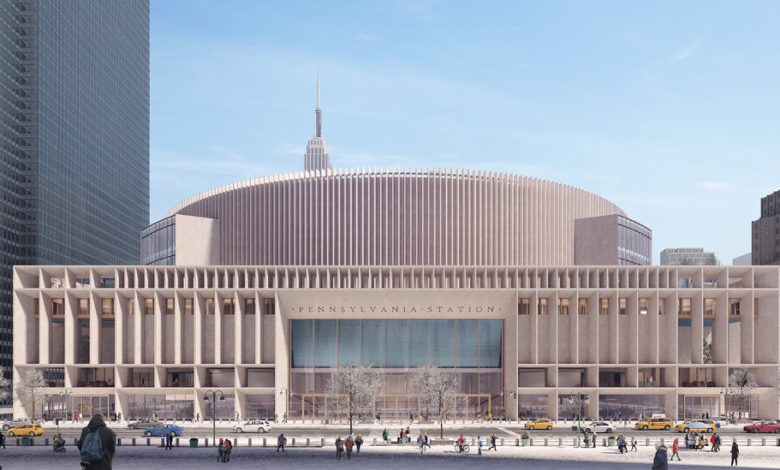Penn Station Is a Perpetual Mess. Change May Be at Hand.

If the latest flurry of news around two dueling plans to fix New York’s Pennsylvania Station has left you scratching your head, you’re not alone. Various officials I have spoken with are also fuzzy on details.
The only thing everyone seems to know for certain is that nothing meaningful ever really happens to improve North America’s busiest and most miserable train hub, despite decades of demands and promises. Hope has long gone to die on the 6:50 to Secaucus.
But now may actually be different.
Why?
For starters, because a highly detailed and, at the moment, clearly superior but unofficial proposal has suddenly emerged to challenge the one that the Metropolitan Transportation Authority has been slowly pulling together. At the very least, the new proposal, from a private infrastructure developer called ASTM North America, may be the disruption needed to get Albany moving.
Outlined for public officials and widely reported last week, ASTM’s six-year, $6 billion plan would reconfigure the cramped, confounding station, which is owned by Amtrak, into a single concourse with high ceilings and a grid of wide corridors that lets daylight, dignity and circulatory logic replace the rat’s maze beneath Madison Square Garden. On the outside of the station, a new, porous stone facade with landscaped terraces and rows of columns would restore a measure of the architectural sensibility and civic symbolism that New York squandered in the 1960s when McKim, Mead & White’s original Penn Station was torn down.
Unlike many others before it, the plan doesn’t involve moving the Garden. That dream, I’m afraid, has gone the way of Betamax and Blu-ray. Instead, ASTM pictures boxing the drum-shaped arena inside a square podium — re-establishing a street wall and the partial footprint of the old station.
A lofty new Eighth Avenue entrance, framed by syncopated rows of columns that subtly nod to the old station and also to its Beaux-Arts sister, the James A. Farley Building, across the street, would lead down to a new 55-foot-high train hall with a map of the city’s streets in relief on the ceiling. To build the hall, ASTM would buy (reportedly for somewhere south of $500 million) and then demolish the Theater at Madison Square Garden, which clings to the west side of the arena, over the sidewalk, creating what has been for decades a two-block dead zone along Eighth Avenue.
ASTM’s team includes Severud Associates, longtime engineers for the Garden, as well as two architecture firms, PAU, based in New York and run by Vishaan Chakrabarti, who has toiled for years on various Garden renovation plans, and HOK, which oversaw the new Terminal B at La Guardia Airport.
For now I leave to others the plausibility of the $6 billion figure and ASTM’s guarantee about covering overruns. Cost aside, there’s a lot to admire here, among other things how the plan prioritizes the surrounding streets and sidewalks and resolves a host of deeply unsexy back-of-house problems involving things like Amtrak storage and the Garden’s loading dock, on which the quality and design of the commuter spaces ultimately depend. Seeking inspiration from exalted precedents like Grand Central Terminal and Schinkel’s Altes Museum in Berlin, ASTM’s architecture at this early stage is a little stiff and self-serious but it clearly conveys the all-important point that a gateway worthy of New York, and of the millions of working people who rely on it, needs to offer more than high ceilings, clear signage and hot bagels. It needs to be a source of public pride.
But the Metropolitan Transportation Authority, not ASTM or anyone else, is for the time being in charge of the official master plan. Back in early 2021, you may recall, Moynihan Train Hall opened in the Farley Building. With its skylights and Tennessee marble, it became an instant attraction and a bright spot for the city during the depths of the pandemic, reminding New Yorkers what a grand public space looks like. Moynihan, however, could never serve more than a tiny fraction of the 600,000-plus commuters who suffer Penn Station each day. So the task of fixing Penn fell to the already overtaxed and straitened M.T.A. and a team of designers and engineers that includes FXCollaborative, WSP, and John McAslan, the British architect who successfully redid London’s King’s Cross Station — the closest analog to Penn Station.
This is pretty much how things stood when my colleagues Dana Rubinstein and Stefanos Chen broke the news this past spring that ASTM had inserted itself into the picture. When I spoke with M.T.A. officials last week, they said they remain on track to deliver full details on the promised plan next summer, meaning a year from now. Their current budget estimate for the project is north of $7 billion. All design and financial details remain on the table, they said. Amtrak and New Jersey Transit, which share the station with Long Island Railroad and the New York City subway system, will eventually sign off on what the M.T.A. cooks up.
Or not.
Are you still with me?
It is possible that over the course of the coming year, the M.T.A., either on its own or because of pressure from Gov. Kathy Hochul, other politicians and/or its partner railroads, may decide, for example, that ASTM or a different developer should take over the project as part of a public-private partnership, or P3.
This, in effect, was how both the new La Guardia terminal and Moynihan were built. It is how the M.T.A. is now retrofitting a number of subway stations with elevators to provide access to people with disabilities. The private company handling that project for the M.T.A. is Halmar International, a subsidiary of ASTM. Halmar is also building a new third rail for the Long Island Railroad.
It’s in this context, I think, that we may decipher the peculiar media event that Ms. Hochul’s handlers hastily organized last week — timed, it seemed, to upstage ASTM’s release a couple of days later of its latest drawings and budget. The governor’s event took place inside the new Long Island Railroad corridor that runs along the northern end of the station, which the M.T.A. just spent several years and a whopping $700 million redoing. That renovation, which includes a new cone-shaped entrance on Seventh Avenue, transformed a claustrophobic rabbit warren into a big, wide passageway, but the price tag was astronomical and the architecture unimpressive.
At the event, standing beside the governor, the M.T.A.’s chief, Janno Lieber, showed a few of FXCollaborative’s latest drawings for the new station, which included a mid-block train hall inside a towering glass concourse that looks to me like a buzzy shopping mall in Dubai.
Ms. Hochul seemed to put distance between herself and those drawings after Mr. Lieber spoke. “We’re not standing here wed to a plan,” she told the crowd. “Everybody has an opportunity to show us their vision.”
It was a peculiar sequence that I think reflects not just ASTM’s disturbance of the narrative, and the fact that anything is still genuinely possible, design-wise, but also the limbo status of the M.T.A.’s. plan. M.T.A. officials are currently insisting that a grand Eighth Avenue entrance of the sort ASTM imagines would not serve enough commuters to justify its public cost. They calculate that only perhaps 30 percent of commuters will use the station on that western side. They are adamant that taxpayers shouldn’t reward the Dolan family, owners of the Garden, by paying for the theater.
Thirty percent of what the M.T.A. estimates will be more than 680,000 daily passengers by 2038 would make the west side of Penn Station the nation’s fourth busiest train hub. And that west side sits over the center of the tracks, where riders enter and exit. But never mind. There is another way to interpret what’s going on here, which involves an entirely separate issue: the special permit by which the Garden is allowed to operate atop the station.
Roll back the clock to 2013 when New York’s City Council, responding to growing calls to fix the station, declined to make the special permit permanent, as the Garden requested, and instead extended it for 10 years, during which time the Garden was supposed to find a new home. The Garden did no such thing.
I think that what we are now seeing in the concept drawings by the M.T.A. is in part a negotiating strategy with the Garden. That proposed train hall with the huge glass ceiling would require the Garden to give up its midblock taxiway and shrink the pedestrian bridge by which 80 percent of its ticket holders reach the arena. The M.T.A. seems to be banking on the Council vote this summer to provide it with leverage. “The Dolans have gotten a pretty good deal from New Yorkers so far,” Mr. Lieber told a meeting of the M.T.A. board. “I don’t want to pay in hundreds of millions more to that account right now.”
In other words, ASTM has decided to buy the Garden’s cooperation. The M.T.A. is treating the Garden as an adversary.
My guess is that the Council will decide this summer to renew the permit but for a limited time under the condition that the Garden cooperate in some way with plans to upgrade the station and its surroundings. Once the special permit vote is settled, the M.T.A.’s strategy and design may look different.
If not, its demands on the Garden seem guaranteed to trigger lawsuits that could tie any renovation up for years in court. And financing a renovation hinges on federal grants, which require a sympathetic administration in the White House.
So the clock is ticking.
If all this still seems dizzying, the bottom line is that the next year will decide the station’s fate. Perhaps not since the demolition of the original McKim, Mead & White building has there been similar momentum and a similar alignment of the political stars. The question now is whether New Yorkers can put aside the caviling and pie-in-the-sky calls to reconstruct the original station or refashion the railway network of the Eastern Seaboard, and finally come together around what’s possible.
Ms. Hochul says Penn Station is a top priority. Let’s hold her to it.




